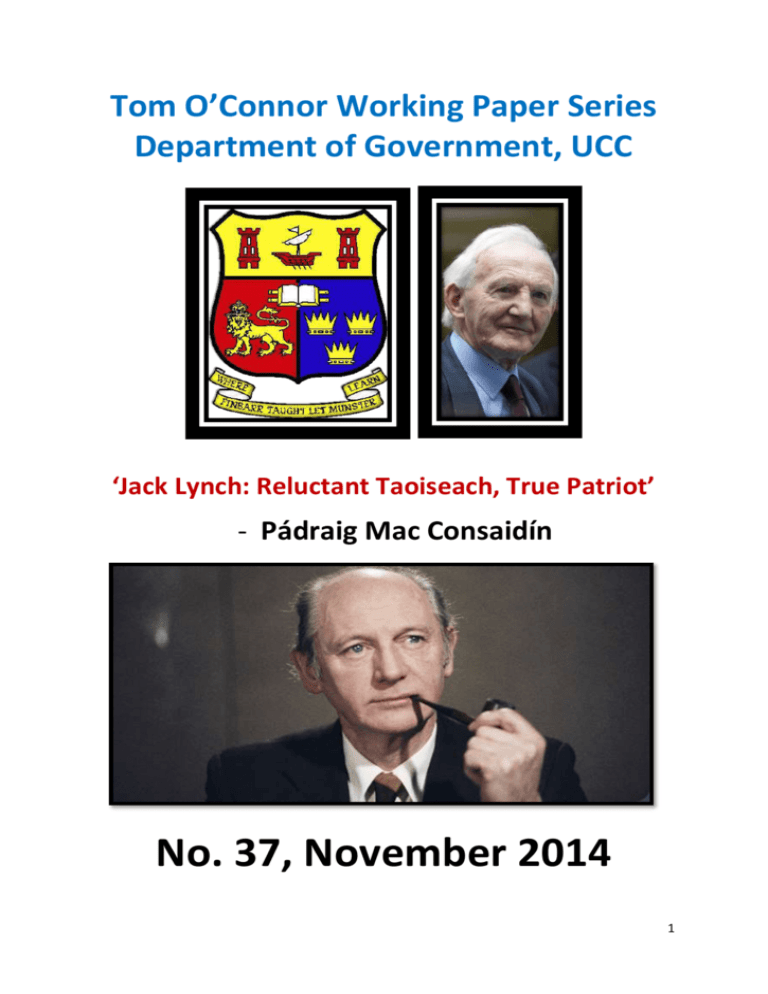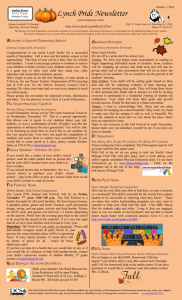No 37 by Mac Consaidin - University College Cork
advertisement

Tom O’Connor Working Paper Series Department of Government, UCC ‘Jack Lynch: Reluctant Taoiseach, True Patriot’ - Pádraig Mac Consaidín No. 37, November 2014 1 Jack Lynch: Reluctant Taoiseach, True Patriot Pádraig Mac Consaidín On the second floor of a corner house, practically under the bells of the landmark Cork clocktower known as the ‘four faced liar’, on 15 August 19171 one of Cork city’s and arguably Ireland’s most famous sporting and political figures was born. The family home of Dan and Nora Lynch in St. Anne’s Churchyard, Shandon which still stands to this day, bears a plaque honouring the birthplace of their son; John Mary Lynch, he is more commonly referred to in the annals of Irish history as Jack Lynch. The Lynch family moved to this well-appointed property, owned by Nora’s grandmother, from their first home a short distance away at 67 Dominick Street2, in an area of Cork that was severely disadvantaged and where many of Cork city’s citizens lived in ‘undesirable conditions’3. Despite being raised surrounded by, but not living in, poverty4, Jack Lynch recalled; “We were comfortable enough for the time. There was always enough on the table, and we were well-dressed with our father a tailor”5. Jack, the youngest of the Lynch boys had the reputation as a ‘wilder’, known to ‘get away with murder at home’6, it is also said that Jack was the bane of the Sexton of St. Anne’s life, constantly playing amongst the headstones in the cemetery adjoining the church 7, evading the Sexton in the lanes and alleys of the area when he was required to make a swift getaway having been discovered in his consecrated playground. As free spirited as he may have been, Jack held a close relationship with his mother Nora, who was known to bring her children to the Cork Opera House on Thursday nights, to witness the Abbey Theatre players perform or hear some variety of concert or other. However, it was with Jack that she shared her love of music in particular8, a passion he held for the rest of his life and an affinity with the Cork Opera House he would never forget, much to the relief of the arts in Cork. This close relationship with his mother meant Jack was deeply affected, possibly more so than his siblings, by the tragic and unexpected passing of Nora when he was still just fifteen. Jack was at home when a nurse from the North Infirmary Hospital, which was located around the corner from the family home, knocked on the door to deliver the fateful news. Many years later Jack summed up his feelings at the time; ‘I was absolutely shattered. I walked around the streets in a daze for hours before coming back home and for years later I was deeply affected by the loss 9.’ Despite the tragedy, Dan Lynch managed to keep the family together and having completed his Primary Certificate, Jack competed for a Cork Corporation scholarship for his second level education, in the 2 Christian Brothers run North Monastery school. With only ten scholarships available, Lynch was tied for the tenth and final scholarship, but as luck would have it, the Corporation made an additional grant available so that both boys who tied for the final position each received a scholarship10. Notwithstanding his reputation as a ‘wilder’ in his younger days, Lynch turned out to be the model student. Rarely absent and not just a pupil in the school’s highest achieving class, one of the better students in the class11. It was while attending the North Monastery that Jack’s prowess on the playing field began to come to the fore. Lining out in both hurling and football, Lynch played with the North Monastery, his local club Glen Rovers and her sister club Saint Nicholas’s Football Club. Having progressed through the underage ranks, Jack made his senior hurling debut for Glen Rovers in the 1934 county championship semi-final against Seandún. It was a less than impressive display. Jack, the all-round sportsman, had been swimming in addition to playing field sports, which is what his lacklustre performance was attributed to. He was brought before the club chairman to explain himself and advised to concentrate on hurling12. The following year would see Jack win back his place on the starting team, while also commencing his inter-county career with Cork in a National League game against Limerick, lining up directly opposite the legendary Mick Mackey13. In 1936, Jack sat his Leaving Certificate examinations. Unsure of his career path, he also sat examinations for the Civil Service, teacher training college and the Electricity Supply Board. However, in a fortunate turn of events, his brother Finbarr became aware of a temporary position in the Dublin District Milk Board. Coincidentally, the chairman of the Board was also the chairman of the Civil Service Hurling Club, which was on the lookout for new talent. Jack Lynch - Cork hurler, was ideal for the position. Lynch accepted the temporary position but, not long after, moved to the civil service in Dublin when he was offered a permanent position there. His sojourn in Dublin seemed destined to become a long term arrangement, but, as it turned out, by December 1936 Lynch was home, assigned to the court service in the offices of the State Solicitors Offices in Cork14. For the next several years Jack worked in the circuit court, developing a knowledge and interest in law and legal proceedings15 that would ultimately lead him to University College Cork to study law. When Lynch registered in 1941, he made up one half of the law class in UCC for that year; he continued his legal studies later in King’s Inns 16 in order to become a barrister. 3 During this time, as he worked for the courts service and furthered his education, Jack remained a feature of the Cork senior hurling and intermediate football teams as well as his beloved club, Glen Rovers. One of the proudest moments of his inter-county career was possibly in 1939 when he was made captain of the Cork hurling team, the first to reach an allIreland final in eight years. Though Cork lost the game, the match has gone down in GAA folklore as one of the most memorable in history. Contested on the day war was declared in Europe17 and in stormy conditions that were almost unplayable18, the game has been more commonly referred to since as the ‘thunder and lightning’ final, due to the inclement weather conditions19. Jack Lynch was more than simply a hurler and footballer though, he was an athlete. Once playing three games in one day, he first played for the Civil Service in the morning, then in a Railway-Cup hurling semi-final that afternoon, before finally lining out for the Munster footballers in the evening. He scored in all three games20. Lynch was a member of the Cork team that won the historic four-in-a-row all-Irelands beginning in 1941, selected as captain once more in 194221. When Cork missed out on the opportunity for their fifth all-Ireland hurling title in a row in 1945 it was still a successful year for Jack, helping the county footballers to all-Ireland glory over Cavan and in the process ending a thirty-four year famine for the Sam Maguire cup in the county. The following year, Jack won his fifth and final allIreland hurling medal, though he would contest one more all-Ireland final before he retired. Glen Rovers were once more crowned Cork county hurling champions in 1950 with Jack in the starting fifteen, though this was to be the end of his competitive career as a hurler and footballer. Declining an invite to play once more with the club in 1951, Jack Lynch brought down the curtain on an illustrious playing careers that yielded; five all-Ireland hurling medals, one all-Ireland football medal, ten county senior hurling medals, two county senior football medals and a Dublin senior football title with the Civil Service22. A roll of honour that will always see Jack Lynch remembered as one of the GAA greats. Today his impressive medal collection is on display in the GAA Museum in Croke Park, Dublin23. The boy from the north side of Cork city had come a long way from honing his hurling skills, in a cramped cellar, whose walls provided the foundations for the historic Shandon steeple. Personal reasons meant 1943 was also an important year in the life of Jack Lynch, for it was then he would meet his future wife Máirín. From Dublin, Máirín was holidaying with a friend in Glengarriff, County Cork. Máirín would meet and develop an interest in the future Taoiseach 4 unaware of his sporting fame and achievements. Indeed on their first encounter, Máirín’s first impression of Jack could not have been too flattering, as he partook in a boisterous sing-song in the guesthouse he and his teammates were sharing with his future wife and her friends. However, before the courtship was to develop into something more serious, Máirín’s mother, an administrator with the Irish Industrial Development Association, would subject Jack to the ‘buy Irish’ test, in keeping with her steadfast belief in supporting Irish businesses. On their first meeting, Mrs O’Connor offered to take the young man’s hat, to see if it were foreign or Irish made - Jack passed the test. Not only was his hat Irish, it was made in Cork by T. O’Gorman’s Cork Cap Factory, located at the time only across the road from the old Lynch family home in Shandon24. Jack remained a patron of many Cork businesses his entire life; O’Gorman’s for his hats and Fitzgerald’s on Patrick Street for his shirts, no Charvet for ‘honest Jack’. Jack and Máirín were wed in 1946 and began their life as a married couple in Cork, renting a modest flat on the South Mall, while Jack was forging a career as a recently qualified barrister. Jack’s status as a sporting icon ensured a trail of political suitors calling to his door, but he was not to enter the political arena until the general election of 1948 25. Standing for Fianna Fáil in the Cork Borough Constituency, Lynch was the second candidate to be returned on the eleventh count of a closely contested ballot26. Though when the Dáil reconvened soon after, Fianna Fáil had lost power to a multi-party coalition and Jack Lynch entered the national parliament as an opposition backbench Teachta Dála (TD)27. Between 1948 and 1951, Lynch established a reputation as an effective parliamentarian, contributing to national debate on many issues while also bringing problems that faced his constituency in Cork to national attention. Two such matters were emigration and youth unemployment, which would also play a prominent role in the subsequent 1951 general election, following the fall of the coalition government amid the Mother and Child controversy28. That 1951 election was to be another successful campaign for Jack Lynch, once more elected in the Cork Borough, Fianna Fáil, supported by a number of independents formed the new Government on June 13, 1951, with Eamon De Valera as Taoiseach29. Lynch, arriving to Leinster House for the meeting of the new Dáil was summoned by De Valera, who informed him that he was to be appointed parliamentary secretary, with special responsibility for the Gaeltacht and Congested Districts30. Jack committed himself to the added duties with his usual diligence, while also regularly attending meetings of Cork Corporation as often as he possibly could, in his capacity as Alderman from 1950 until his resignation in 195731. Before he was to 5 resign from the Corporation however, Lynch would have to face into his third general election in six years. From 1954 he was to be content once more with a seat on the opposition benches, while also returning to Cork in an attempt to revive his legal career. Though his spell as an Alderman was relatively short, in reality Lynch was more effective as a national parliamentarian than as an elected member of local government. Despite being in opposition, Jack continued to question the then government on issues that affected the nation and his borough in Cork, garnering a reputation as a strong constituency advocate32. Elected once more in the 1957 general election, Lynch received a call from the Taoiseach while working in his office on St. Patrick’s Day; he was to make his way to Dublin at his earliest convenience. It was during this meeting Lynch would be offered his first ministry, though it would take two further meetings and consultation with Máirín before he would accept. This promotion would also signal an end to Lynch’s career at the bar and his position on Cork Corporation. Lynch brought a range of skills and experience to the position of Minister for Education. A former civil servant and a fluent Irish speaker, Lynch was afforded a warm welcome by those in his new department, especially his Private Secretary, Jim Dukes (father of the future Fine Gael leader, Alan Dukes), with whom he developed both a strong working and personal relationship with. Lynch did not remain in the ministry a great deal of time, but during his stewardship probably the most substantive impact he had was removing the marriage bar on employing married women as teachers at primary level33. A number of events conspired in 1959 that would see Lynch change ministries. Dr Ken Whitaker, one of the youngest secretaries of the Department of Finance had penned his Economic Development document, the forerunner to the White Paper on Economic Expansion. De Valera had stepped down as Taoiseach, to be elected President, with Seán Lemass becoming Taoiseach. Recognising the need to address Ireland’s stagnant economy, Lemass appointed the erudite Lynch to the key ministry of Industry and Commerce, to assist in the implementation of his and Whitakers plan to develop the Irish economy and adopt a policy of free trade. During his tenure as Minister for Industry and Commerce Lynch was also keen to extol the virtues of Cork as a destination for new industry in Ireland while assisting with the expansion of existing companies in the county. This was evident in Lynch’s speech at the opening of the Whitegate Oil Refinery in September of 1959 when he spoke of Irish Steel’s expansion, the imminent arrival of Goulding’s fertiliser plant and the new airport which was 6 still under construction. Lynch promised that the future of Cork in terms of employment was becoming more attractive. Another matter Lynch alluded to during his speech was the Cork Opera House rebuilding project34. This project was close to Jack’s heart - no doubt recalling the days his late mother would bring him to see shows at the theatre and he sought to help the project as best he could. In all, Lynch would serve as Minister for Industry and Commerce from 1959-1965, where he toiled to change a department who knew nothing but protectionism, began the tentative steps of preparing Ireland for membership of the then European Economic Community (EEC), while gaining experience and making allies that would be invaluable to him in years to come. The year 1965 saw another general election and Fianna Fáil once more returned to government, this time winning seventy-two seats in the new Dáil35. Lemass used the opportunity when forming his new Government to promote younger members of the party to key positions. One promotion, though not of the new generation, was Lynch to the finance portfolio36. Here, working closely with Ken Whitaker and further developing a relationship and friendship he would call upon later at critical junctures in the nation’s history, Lynch’s early months in his new assignment were challenging to say the least. The national finances were in disarray and requesting his ministerial colleagues to cut expenditure was one of the first tasks Lynch undertook as minister. In the following months he would introduce a budget that would endear him to neither his government colleagues nor the people of Ireland. But Lynch did what was required of him, though it would not be enough to stem a growing deficit that would require a supplementary budget, and intense confrontations with some members of cabinet 37. It could be argued that Lynch did not have adequate time as Minister in the Department of Finance to effect the necessary changes to the national finances, however in late 1966 a challenge of a new kind would present itself to the Shandon native. Lemass implied prior to the 1965 general election that it may be the last he would lead his party into. The financial difficulties of the State, along with defiant younger members of the party meant that by late 1966, Lemass was ready to hand over the mantle of leadership to a successor. Sensing an impending change in leadership, Charles Haughey and George Colley bolstered support for a possible contest, even before Lemass had officially resigned his position. Possibly bearing this in mind and keen to avoid a power struggle within the party, Lemass favoured an agreed successor and he wanted Lynch to be that successor. At that point in time a leadership contest was seen as a two horse race, Haughey versus Colley. Yet Lynch 7 was installed as favourite were he to decide and contest the leadership, possibly due to the swell of support from backbench colleagues who favoured the amiable Cork man, as well as the backing of the sitting leader and Taoiseach. Hesitancy in making his leadership intentions known has often led to Jack being labelled a ‘reluctant’ Taoiseach, but this was not the case. It was out of consideration for Máirín and her mother, who was gravely ill at the time that led to Jack’s hesitancy in making his decision. Later, in a letter to the Cork Examiner, Máirín would make clear her husband’s reasons for delaying his decision to assume the leadership was out of consideration for her and her mother, she dispelled the myth of Jack being a reluctant leader of either Fianna Fáil or the Irish State38. Lynch allowed his name to go before the party for consideration and was elected leader and by extension, Taoiseach 39. Before Jack took charge of the affairs of state, he would first return to Cork and a hero’s welcome. The first Cork man to become Taoiseach in the history of the state, what greeted the new leader must have far exceeded the expectations of even the unassuming Jack Lynch. Travelling in a classic American Cadillac, tens of thousands lined the roads and cheered their native son, reminiscent of President Kennedy’s visit to the city a number of years previously. Bands roused the crowds with musical renditions and the processional route was illuminated by bonfires and burning tar barrels40, reminiscent of when a young Jack Lynch caught his first glimpse of political campaigning in 1932 when De Valera held a rally in Blackpool and Shandon. Indeed Jack took De Valera’s old route to enter the city; down Dublin Hill, passed the Glen Rovers’ Hall, up Gerald Griffin Street before descending Shandon Street, across the river Lee and into the city centre41. This route unquestionably held more sentiment for Lynch than De Valera; he was traveling through the areas he grew up in. The ‘wilder’ from St. Anne’s Churchyard was returning home, the conquering political hero, leader of his country. In the context of his predecessors and indeed some of his successors, Lynch as Taoiseach was a modern leader and moderniser42. Yet his time as Taoiseach would be challenging; within two years of taking leadership he faced the threat of a resurgent Irish Republican Army and subsequent fragmentation of Northern Ireland under violence, which ironically began from a campaign seeking civil rights. Though the tragedy of the Northern Ireland situation had been foreseen by Lynch, his government were ill prepared when the forewarnings became reality. In making a televised address to the nation in 1969, Lynch beseeched ‘the British Government to apply immediately to the United Nations for the urgent dispatch of a Peace-Keeping Force to the Six Counties of Northern Ireland’. Lynch had also requested that the Irish representative to the United Nations inform the Secretary General (of 8 the UN) of this request43. Lynch, under pressure from some quarters to make a military intervention in the escalating conflict, resisted, recognising the overwhelming odds against any success for the ill-equipped Irish Army against the potency of the British Armed Forces in the North. Criticism for the abstention mounted, yet despite such criticism, Lynch was unwavering in his commitment to democratic institutions, illustrated during the arms crisis. When presented with evidence that senior ministers were involved in a plot to import arms for distribution in Northern Ireland, they were removed by Lynch. Their overnight sackings will be remembered as one of the most significant acts in the history of the state44. The Northern Ireland issue is without question the single matter that dominated Jack Lynch’s time as Taoiseach, therefore, perhaps his greatest legacy from this period was preserving peace on the island of Ireland as a whole. During this period which tested Lynch’s resolve leader of the Fianna Fáil party and as leader of the country, it was his skill and competency as a statesman that steered him through, drawing inspiration and counsel from Máirín and quite often advice from those he trusted most; Ken Whitaker, Desmond O’Malley and to a lesser extent, but at no less a critical moment in Lynch’s career, David Marcus. Lynch also brought to fruition a process he helped begin in the early 1960s in his capacity as Minister for Industry and Commerce, which he continued as Minister for Finance and completed as Taoiseach. Ireland’s eventual accession to the EEC in 197345. Lynch’s reign as leader of Fianna Fáil proved challenging. An unprecedented building boom during the period offered opportunities for large profit making for both speculators and large building developers. Fianna Fáil, in government since 1957, contained within its ranks a number of ministers who exuded arrogance. Others grew uneasy at the relationships that were forming between government ministers and the building industry. Lynch, recognising this growing association decided that the process of political donations to the party needed to be made transparent. According to Des Hanafin who became the controller of the fund-raising operation, Lynch had no hesitation in returning any donation he felt could be compromising to the party46. Another challenge Lynch faced as party leader, would be how to deal with insubordinate senior members of the party, often government ministers. He encountered these issues too often as Taoiseach during a critical period in the State’s history, from the HaugheyBoland-Blaney disorganised leadership challenge of 1971 and the unruly Árd Fheis, to the arms crisis and the political fallout thereafter47. Also during this period, Fianna Fáil, though a formidable campaign force at election time; was in need of modernisation as a party. Lynch began this undertaking during the party’s period in opposition from 1973 to 1977, but despite 9 any reforms he would make, as a result of the 1977 general election, both he and his party would ultimately be held responsible for the type of auction politics that exemplify general elections in Ireland today. During his time as Taoiseach, Jack continued to travel to Cork as much as possible and often holidayed with Máirín at the couple’s retreat near Ballydehob in west Cork. One instance that demonstrates Jack’s bond with his native city can be seen in his dedication to saving Skiddy’s alms-house in Shandon. Standing only yards from where Jack was born, the building was destined to be demolished. On hearing this, Jack took a personal interest in the matter, assigning the parliamentary secretary of the Department of Finance to report to him on developments concerning the issue and hold public hearings on the matter. Jack’s intervention in the process eventually saved the building from destruction and he was present at its reopening some years later48. On 5 December, 1979 Jack Lynch resigned as Taoiseach and leader of Fianna Fáil. His decision followed months of disquiet within the party and further moves to remove him as leader. A catalyst to Lynch’s decision may have been the loss of two by-elections, when even the Irish Times intimated that Lynch was no longer the political power he once was 49. Despite his modest and unassuming manner, these setbacks must have been difficult to endure for the man Liam Cosgrave, leader of the opposition, once described as the most popular politician in Ireland since Daniel O’Connell50. Jack embraced his retirement and stepped back completely from national politics. He remained active in business and sporting endeavours, serving as a director for a number of companies and as President of the Glen Rovers hurling club. He continued to travel to Cork, often entertaining guests at the Lynch holiday home in west Cork. Both he and Máirín also continued to travel extensively, visiting Russia, China, Turkey and their favourite destination, Italy. Lynch’s death in 1999 left Cork feeling a sense of great loss for their native son, their ‘real’ Taoiseach. Thousands attended his funeral at the North Cathedral in Shandon, with many thousands more lining the route of his funeral procession through the city to St. Finbarr’s Cemetary. Jack Lynch’s memorial stone in the cemetery holds the inscription, ‘Happy is the man who finds wisdom’. 10 Lynch’s place in Irish history is assured - how could it not but be, given the catalogue of accomplishments he achieved during his lifetime? Michael Mills, the former Ombudsman wrote: Historians in the future will assess his place in the calendar of 20th century Irish leaders, but on the question of popular leadership, his place has long been decided. He was unequalled. Not only Fianna Fáil supporters but thousands of people who never voted Fianna Fáil voted Jack Lynch. This sentiment was echoed by Desmond O’Malley who delivered the graveside oration at Lynch’s internment at Saint Finbarr’s Cemetery in Cork. O’Malley proclaimed: Confronted with some of the most difficult decisions to face any Taoiseach of the modern era, he took determined and resolute action to defend democracy and to uphold the rule of law. Upon such foundations are freedom and prosperity built. Had this country taken the wrong turn thirty years ago, I fear to think what might have befallen us. We didn’t, and for that alone Jack Lynch deserves his place in history. Continuing the subject of Northern Ireland, O’Malley commented; ‘for the safe existence of this democratic state in which we live today is very much Jack Lynch’s legacy’. In concluding his remarks, O’Malley mused that the life of Jack Lynch would inspire young people to follow his example ‘and to be publicly generous of themselves at a time when the commitment of integrity is so badly needed’. Jack Lynch’s memorial stone in the cemetery bears the inscription; ‘Happy is the man who finds wisdom’. Lynch found more than wisdom during his years; he found success in almost everything he undertook. Jack Lynch will always be remembered as a scholar, sportsman, politician, leader, peacemaker, devoted husband and son of Cork. List of References 11 1 Keogh, D. (2009) Jack Lynch – A Biography, Dublin: Gill and MacMillan. p.2. 2 National Census (1911) [Online]. Available at http://www.census.nationalarchives.ie/reels/nai001872186/ (Accessed: 11 November, 2012). 3 Keogh, D. (2009) Jack Lynch – A Biography, Dublin: Gill and MacMillan. p.2. 4 Ibid. p.5. 5 O’Mahony, T.P. (1991) Jack Lynch – A Biography, Dublin: Blackwater Press. p.31. 6 Ibid. p.29. 7 Ibid. p.30. 8 Keogh, D. (2009) Jack Lynch – A Biography, Dublin: Gill and MacMillan. p.7. 9 Dwyer, T. R. (2001) Nice Fellow: a biography of Jack Lynch, Cork: Mercier Press. p.15 10 Keogh, D. (2009) Jack Lynch – A Biography, Dublin: Gill and MacMillan. p.12. 11 Ibid. p.12-13. 12 Lynch, J. (1973), ‘Reminiscences’, in Liam O’Tuama et al. (eds), The Spirit of the Glen 1916-1973, Cork: Blackwater Press. p.110 13 Keogh, D. (2009) Jack Lynch – A Biography, Dublin: Gill and MacMillan. p.14. 14 Ibid. p.14-15. 15 Lynch, J. (1979) ‘My life and times’, Magill, November, p.36-37. 16 Keogh, D. (2009) Jack Lynch – A Biography, Dublin: Gill and MacMillan. p.18. 17 The Irish Independent (1939) Britain and France declare war: Reich will not capitulate Fuehrer says. The Irish Independent. 4 September. P.1. 18 O’Tuama, L. (2000) Jack Lynch: Where he sported and played. Dublin: Blackwater Press. p.173-174 19 20 Pat’O (1939) Hurling final played in thunderstorm: Kilkenny gain their twelfth title. The Irish Times, 4 September, p.11. Keogh, D. (2009) Jack Lynch – A Biography, Dublin: Gill and MacMillan. p.19. 21 IMAGE – Available on the GAA website but also in; Keogh, D. (2009) Jack Lynch – A Biography, Dublin: Gill and MacMillan. 22 Hannigan, D. (2005) Giants of Cork Sport, Cork: Evening Echo. 23 Croke Park (2013) Exhibitions: Medal Collections, [Online]. Available at: http://www.crokepark.ie/gaamuseum/exhibitions/collections/medal-collections (Accessed: 15 March, 2013). 24 Cork City Libraries (2013) Cork Past and Present, [Online]. Available at: http://www.corkpastandpresent.ie/mapsimages/corkphotographs/michaelolearyphotos/corkbutterm arket/ (Accessed: 19 March, 2013). 12 25 Keogh, D. (2009) Jack Lynch – A Biography, Dublin: Gill and MacMillan. p.26-27. 26 Ibid. p.30-31. 27 The Irish Times (1948) ‘New Ministers Begin Their Tasks: Opposition Activity’, 20 February, p.1. 28 The Irish Times (1951) ‘Dissolution’, 5 May, p.7. 29 The Irish Times (1951) ‘Mr. De Valera is elected by 74 votes to 69: new government has the smallest majorty on record’, 14 June, p.1. 30 Keogh, D. (2009) Jack Lynch – A Biography, Dublin: Gill and MacMillan. p.40-41. 31 Ibid. p.42. 32 Ibid. p.46-49. 33 Ibid. p.50-56. 34 Ibid. p.70-79. 35 The Irish Times (1965) ‘Dáil will elect Taoiseach to-day’, 21 April, p.1. 36 The Irish Times (1965) ‘Pen-pictures of Ministers’, 22 April, p.6. 37 Keogh, D. (2009) Jack Lynch – A Biography, Dublin: Gill and MacMillan. p.96-99. 38 Ibid. p.116-119. 39 IMAGE – Available at http://politico.ie/component/content/article/3124-jack-lynch-photo-diary?showall=1 Jack Lynch leaving the Dáil to go to the President and receive his seal as Taoiseach. 40 The Cork Examiner (1966) ‘Cork enthusiastic welcome for new Taoiseach’, 14 November, p.1. 41 Horgan, J. (1966) ‘Cork takes Lynch (again) to its heart: a full blooded welcome’, The Irish Times, 14 November, p.11. 42 Keogh, D. (2009) Jack Lynch – A Biography, Dublin: Gill and MacMillan. p.476. 43 The Irish Times (1969), ‘UN force in North sought by Lynch’, 14 August, p1. 44 Keogh, D. (2009) Jack Lynch – A Biography, Dublin: Gill and MacMillan. p.476. 45 IMAGE – Jack Lynch signs Ireland’s accession to the EEC. 46 Keogh, D. (2009) Jack Lynch – A Biography, Dublin: Gill and MacMillan. p.125, 126. 47 The Irish Times (1971) ‘Uproar at Fianna Fáil Ard-Fheis: Scuffles between Lynch and Boland supporters’, 22 February, p.7. 48 Ibid. p. 486. 49 The Irish Times (1979) ‘More of a convulsion’, 9 November, p.11. 50 Keogh, D. (2009) Jack Lynch – A Biography, Dublin: Gill and MacMillan. p.445. 13







